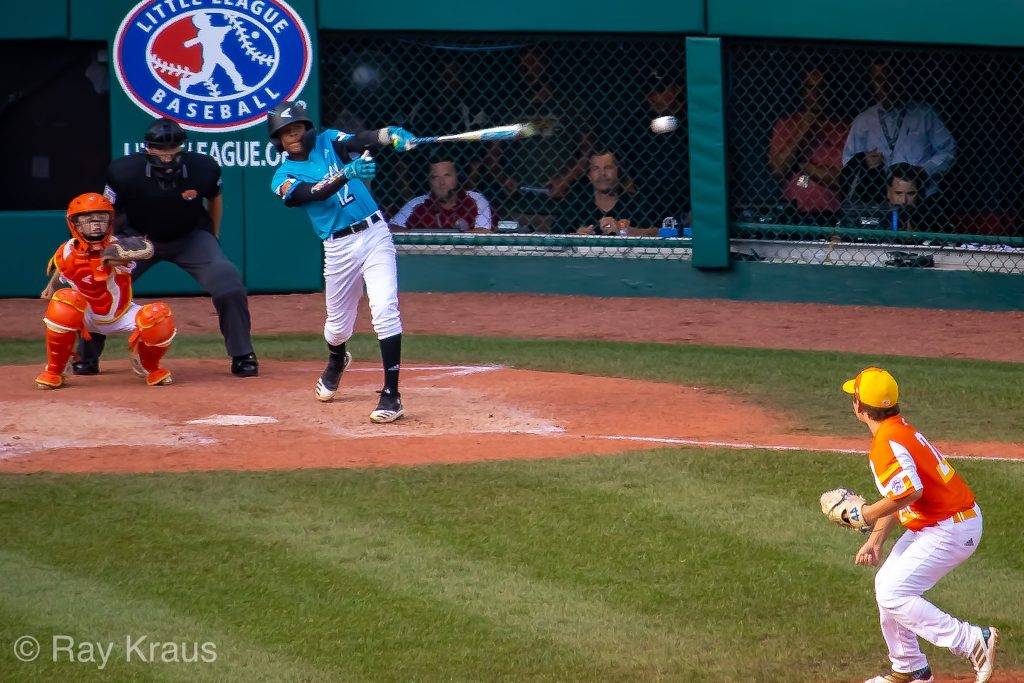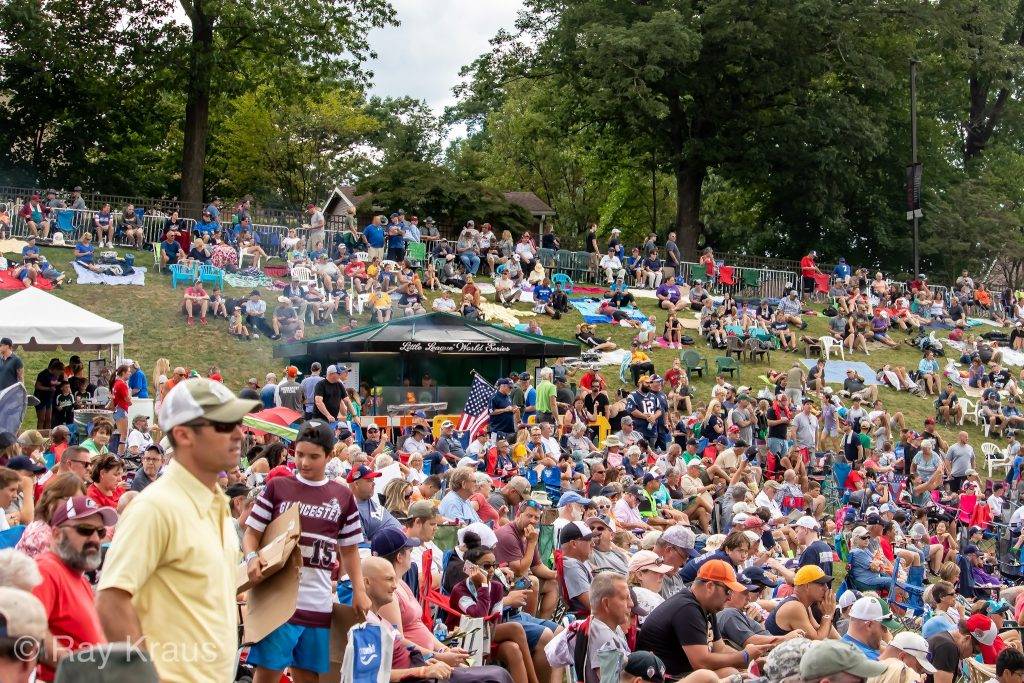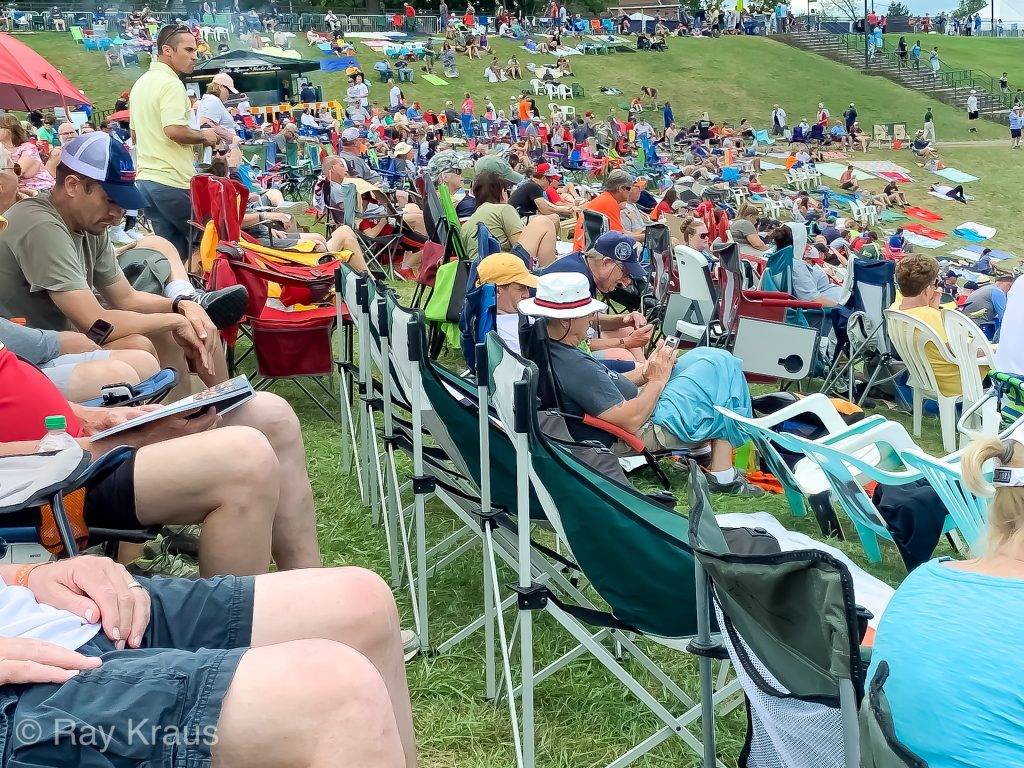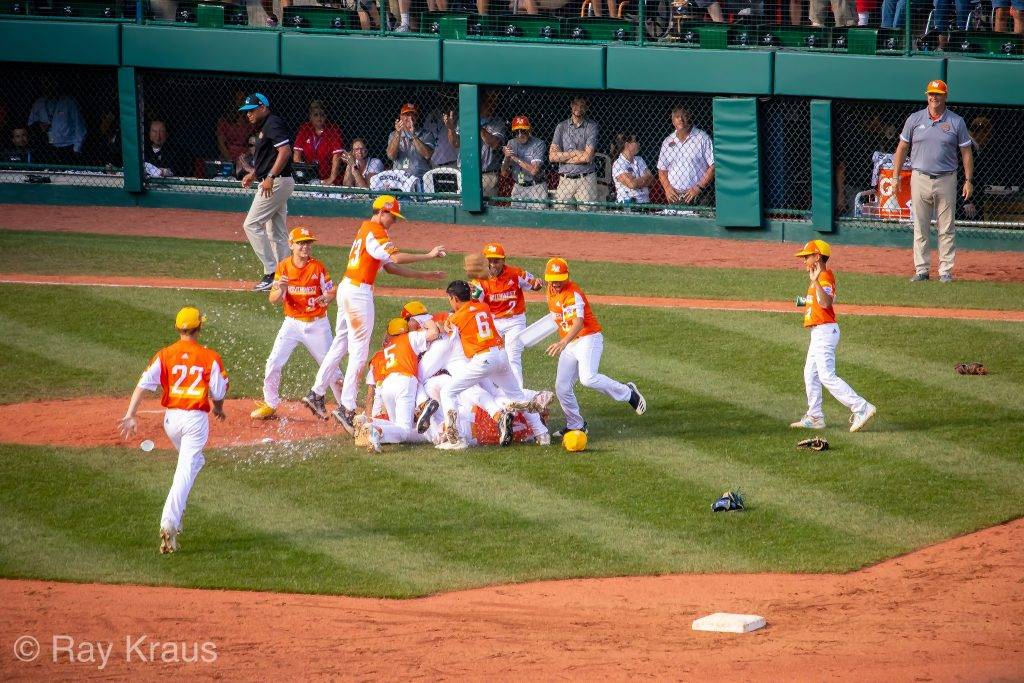
On a beautiful, sunny, late summer afternoon I’m sitting on a hill in northern Pennsylvania watching 12-year-olds demonstrate the perfection of the game. Welcome to the Little League World Series (LLWS) where “the best seats are on the hill.” While some wish they were in Lamade Stadium’s grandstands, most of the people I met love being on the hill. They love the camaraderie and the almost ready for Autumn breeze that cools the bright sun.
What can be better than two days in the north-central Pennsylvania hills watching the game we love? It doesn’t matter that the players are twelve, it’s still the same game and the level of competition dramatic.
The Game’s Perfection
The Setting
It’s the bottom of the sixth (and last inning) of the championship game. Louisiana is leading Curacao 8 – 0, with two men out. Egan Prather has pitched the entire game and wants to be on the mound for the last out. Earlier in the tournament, Prather pitched 5 1/3 innings of one-hit ball to help Louisiana avoid elimination. That day, he struck out ten kids from New Jersey. Today he continued to dominate, allowing only two hits while striking out six.

Little League rules state that a pitcher is not allowed to throw more than 85 pitches in a game. However, Prather has thrown only 69 pitches through the first five innings and is well under the limit when Curacao’s Curley Martha comes to the plate with two out and no one on base.
Martha is no slouch. To date, he’s hit .563 with a tournament-leading three home runs to help Curacao get to the finals. One of these was a two-run shot against Japan in Saturday’s International Bracket final.
Martha also seems to match Prather’s competitive fire. Curacao was likely headed for a loss, but Martha wasn’t going to be the one to make the last out. He’ll leave it to one of the next guys to swing and miss or hit a weak ground ball to end the game. Let him walk slowly back to the dugout while Louisiana celebrates.
The Encounter

With two strikes, Martha fouls off pitch after pitch. Prather keeps challenging him, and his pitch count continued to grow. Every once in a while, he walks behind the mound, uses the rosin bag, throws it down and climbs the hill to make his next pitch. At one point, shortstop Stan Wiltz takes a few steps toward the mound to check-in and show some support. Prather glares at him, says something like (I assume) “I got this, leave me alone,” and Wiltz walks back to his position.
Martha wants a pitch he can drive, something in the strike zone. Since its a two-strike count, Prather doesn’t have to throw something over the plate. He can throw his best pitches that are around the edges and corners of the strike zone. Pitches Martha shouldn’t be able to hit. Martha’s only recourse is to foul off these pitches in the hopes of getting a better one he can drive.

The scenario repeats eight times. Prather paces to the back of the mound, uses the rosin bag, climbs the hill, gets set, pitches, Martha swings – foul ball. The suspense increases with each pitch. Prather’s plight increases when he throws his 85th pitch. Prather will continue to pitch to Martha but must relinquish the mound if he gets on base. Of course, Prather does not want to be anywhere other than the mound when Louisiana wins.
Each player glares at the other. Again, Prather paces to the back of the mound, uses the rosin bag, climbs the hill, gets set, pitches, Martha swings – foul ball.
Finally, on the 88th pitch, Martha lines out to shortstop Wiltz and Louisiana’s celebration begins. They’re the last team standing of the 7,700 teams that started the tournament in their respective regions. They meet at the mound, parade the banner around the field and touch the Howard J. Lamade bust in centerfield. 1
Celebration!
“The Game of Ball is Glorious”

Baseball is the only team sport where this type of Mano a Mano confrontation is the centerpiece of the competition. For example, in football, the offensive line protects the quarterback as he throws passes to his teammates. There are 11 players on the opposing team, in various positions, who try to stop what he plans to do.
Similarly, in basketball, while a defender opposes the player with the ball, that defender can be assisted by another player or two. Moreover, the outcome of the interaction is not definitive, the player can pass the ball, so someone else can try.
Tennis, match play golf, boxing and wrestling include the single-player confrontation, but they are not actual team games. Players can be organized into groups and wear the same uniforms, but they are still individual contributors.

That’s why we remember Charlie Root pitching against Babe Ruth in the 1932 World Series and the mythical “called shot.” Or Ralph Branca vs. Bobby Thompson in 1951 and the “Shot Heard Round The World” when the Giants won the pennant. Or, Prather vs. Martha in the Little League World Series.
The confrontation between pitcher and hitter is central to the game and incredible. Walt Whitman would say “glorious.”
That’s why it is impossible for me to resist baseball’s allure. I will always find a ballpark and relish everything the game was, is and ought to be. Give me a diamond, nine guys on each side, a few balls and bats and I’m at home.
Williamsport, Pennsylvania
Williamsport, PA (est. population 28,347) is the county seat Lycoming County. The west branch of the Susquehanna River separates it from South Williamsport, the location of the Little League’s headquarters and the World Series. The city is in north-central Pennsylvania between the Allegheny Mountains to the north and west and the Appalachian Mountains to the south.2 For baseball fans, the location of Howard J. Lamade Stadium, the series’ home, is a little slice of heaven: a cute little ballpark nestled in the northern Pennsylvania hills.

The Little League began as a three-team league in Williamsport in 1939 – with three teams: Jumbo Pretzel, Lycoming Dairy and Lundy Lumber. It added a second league from Williamsport the next year. Since then, the Little League has grown into an international organization of approximately 200,000 teams in every U/S. State and 80 countries worldwide.3

In 1947, the Maynard League from Williamsport defeated a team from Lock Haven, PA to win the first LLWS.4 In 1952, the first international teams played in the series. Today, 7,700 teams from around the world compete in regional tournaments. Ultimately 16 teams represent eight regions from the United States and another eight from around the world compete in Williamsport for the championship.5
Of course, people throughout the region celebrate the Little League and its World Series. I enjoyed the welcoming signs hung from businesses and private homes. I also loved the statues of players, on each corner of Market Square in the center of town.
If You Go
What am I saying? Of course, you should go!
The gates open at 8:00 AM (occasionally earlier). To get good seats, fans begin to line up earlier, around 6:00 AM, although I met some who were there even earlier. Once the gates open, fans race to their preferred seating locations.
There are15,000 seats in the grandstand and up to 40,000 seats (they claim) on the hill behind the outfield.

Sitting on The Hill
Most attendees sit on the hill behind the outfield fence.

The steep hill is divided by a flat area that includes a paved walkway, that enables people to walk from end to end. At the top of the hill are stairs that lead to exits.

The area in front of the walkway is used only for seating. Although some people sit behind the walkway, that area is used almost exclusively as the famous sliding area. Kids and the young at heart use pieces of cardboard to slide down the tall and steep hill.
Toward the end of this year’s championship game, soccer great, Julie Foudy left ESPN’s broadcast booth and gave the hill a try. It brought back good memories. Twenty years before, I was at the Rose Bowl with the Nomad family watching Foudy play, and the Women’s National Team (aka “the 99’ers”) win the World Cup. Now here I was watching her barrel down the hill at the LLWS.
Of course, every fan has their individual preference as to what is a good seat. The people I sat with chose a location right where the hill started to flatten out. They were in front of some bushes that surrounded the flagpole, which is in front of the walkway. Others choose to sit closer to the field on the steep angled part of the hill.
You Need the Right Chair
Different types of chairs facilitate seating:

Plastic With Half Legs 
Short Folding Chairs 
Tall Folding Chairs
- Plastic chairs where the back legs are cut in half, making them perfect for sitting on the steepest part of the hill – closest to the action.
- Folding chairs that have very short legs, like the ones you see regularly at the beach are a good choice. These chairs work nicely on the gradual sloped and flat part of the hill. They enable the viewer to see over the people in front of them without blocking people behind them.
- Folding chairs with standard height legs are best for the flat areas in the back because they can block the view of others if placed in front of them. Moreover, they can’t handle the steep angles.
The Fans
The choice of seating engenders different behaviors. In my two days of extensive research, I noticed five different kinds of fans. You have to decide which you are going to be.
Stadium Wannabees
Some fans head to “Will Call” when the gates open and wait for any remaining tickets to be distributed. I originally, understood that the grandstand was only for VIPs and the players’ families and their friends. However, I met people who said that there are a few thousand tickets that remain and are distributed to fans.
Long lines at “Will Call”

The problem is, if you are alone and go for the stadium seats, you lose a chance at good positions on the hill. So here is the strategy: you need to choose the seating location to target before the gates open. If you have family or friends with you, part of the group can wait at “Will Call” while the others stake out a position on the hill. However, everyone needs to be at “Will Call” when the tickets are distributed. Each person only receives one ticket. They can’t have extra tickets for friends.
Note that some of the VIPs don’t use their tickets. From the hill, you will see many empty seats in the grandstands.
Hill – Early Birds
Members of this group, park close to the stadium, near the top of the hill. In so doing, they will likely pay a small fee to near-by residents or businesses to park on their property. When the gates open, they are in a position to get the best seats available on the hill. They stake their claim with blankets for friends and family to use when they arrive later or as a buffer between other attendees.
Hill – Gate Openers
I was in this group. Not knowing any better, I followed the “Stadium Parking” signs as I headed up Market Street toward the stadium. The parking here is free. However, it is below the stadium, so I had to walk up the hill to get to the stadium. By the time I got to the seating area, there were no prime locations.
Moreover, good spots were limited since I did not have the requisite chair. I mistakenly assumed that most fans sat on the ground. Without the right chair, the dramatically angled slope was uncomfortable. However, I needed to be as close to the slope as possible, so I could see over others that had chairs.
Luckily, I charmed a group of “Early Birds” and asked if I could sit in the area that they had declared as theirs. I sat next to them both days.
Hill – Late Nicks
These people get to the grounds hours after the gates open and try to squeeze their chairs into any available space. However, they are polite and make sure that they do not block others who are already situated.
Hill – Jerks
Jerks get to the grounds late and place chairs wherever they want without considering whose view they are blocking.
Is Baseball Like a Liquid?
During my two days on the hill, I considered the question I asked at the beginning of my adventure:
“Does Baseball like a liquid take the shape of its container?”
Thomas Boswell
After all, I have now been to venues in four different countries, Mexico, Canada, England, and the United States. To date, I have attended games at 23 MLB ballparks. Not to mention, I sat in Doubleday Park in Cooperstown for a few innings. I also saw the College World Series at TD Ameritrade Stadium in Omaha. Now I was at the Little League World Series in Williamsport.
Even though I still have seven more ballparks to see, I am ready to declare, unequivocally, that the experience at each ballpark is different. The game transformed as I went from site to site.
It’s not that the strategy or the way the game is played is different. The adventure, the feeling, the view and sounds of the crowd make each experience unique.
My next stop on the tour is the makeup game in Tampa. It replaces the one I missed in early May when I was too ill to make the drive from Miami. A few days later, I leave for a long trip out west to complete my journey to all 30 ballparks. I can’t wait.
- Information for this is from my scorecard and/or Chris Masse, “Best of the Bayou” Williamsport Sun-Gazette, August 26, 2019
- Wikipedia – Geography of Pennsylvania
- Wikipedia – Little League Baseball
- Wikipedia – Little League Baseball
- D. Everett Smith, “A look back to when the Series first welcomed world’s players, Williamsport Sun-Gazette August 26, 2019





















Hi there, I found your site by way of Google at the same time as looking for a similar subject, your web site came up, it appears good. I have bookmarked it in my google bookmarks.